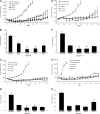Mice expressing a humanized form of VEGF-A may provide insights into the safety and efficacy of anti-VEGF antibodies
- PMID: 17360669
- PMCID: PMC1805509
- DOI: 10.1073/pnas.0611492104
Mice expressing a humanized form of VEGF-A may provide insights into the safety and efficacy of anti-VEGF antibodies
Abstract
VEGF-A is important in tumor angiogenesis, and a humanized anti-VEGF-A monoclonal antibody (bevacizumab) has been approved by the FDA as a treatment for metastatic colorectal and nonsquamous, non-small-cell lung cancer in combination with chemotherapy. However, contributions of both tumor- and stromal-cell derived VEGF-A to vascularization of human tumors grown in immunodeficient mice hindered direct comparison between the pharmacological effects of anti-VEGF antibodies with different abilities to block host VEGF. Therefore, by gene replacement technology, we engineered mice to express a humanized form of VEGF-A (hum-X VEGF) that is recognized by many anti-VEGF antibodies and has biochemical and biological properties comparable with WT mouse and human VEGF-A. The hum-X VEGF mouse model was then used to compare the activity and safety of a panel of VEGF Mabs with different affinities for VEGF-A. Although in vitro studies clearly showed a correlation between binding affinity and potency at blocking endothelial cell proliferation stimulated by VEGF, in vivo experiments failed to document any consistent correlation between antibody affinity and the ability to inhibit tumor growth and angiogenesis in most animal models. However, higher-affinity antibodies were more likely to result in glomerulosclerosis during long-term treatment.
Conflict of interest statement
Conflict of interest statement: The manuscript describes the use of several anti-VEGF antibodies, including bevacizumab. The authors are employees of Genentech, Inc., the manufacturer of bevacizumab.
Figures




References
-
- Ferrara N. Endocr Rev. 2004;25:581–611. - PubMed
-
- Ferrara N, Hillan KJ, Gerber HP, Novotny W. Nat Rev Drug Discov. 2004;3:391–400. - PubMed
-
- Gasparini G, Longo R, Toi M, Ferrara N. Nat Clin Pract Oncol. 2005;2:562–577. - PubMed
-
- Ferrara N, Kerbel RS. Nature. 2005;438:967–974. - PubMed
-
- Jain RK, Duda DG, Clark JW, Loeffler JS. Nat Clin Pract Oncol. 2006;3:24–40. - PubMed
Publication types
MeSH terms
Substances
LinkOut - more resources
Full Text Sources
Other Literature Sources
Molecular Biology Databases

